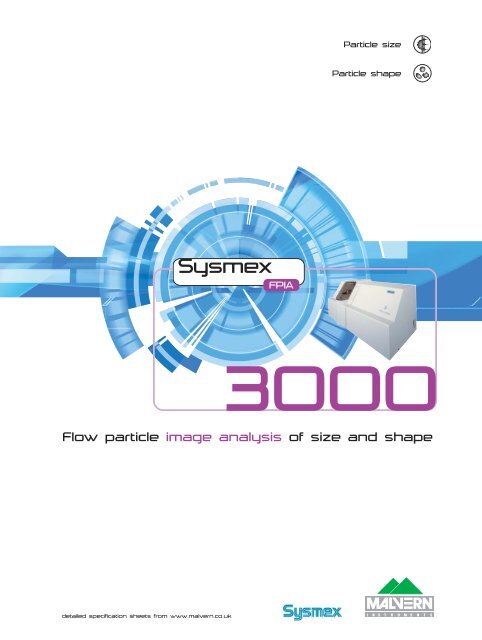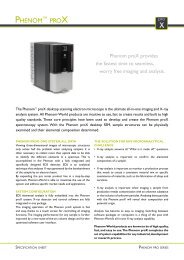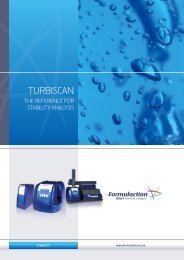Brochure: Sysmex FPIA 3000 Flow Particle Image Analyzer ...
Brochure: Sysmex FPIA 3000 Flow Particle Image Analyzer ...
Brochure: Sysmex FPIA 3000 Flow Particle Image Analyzer ...
- No tags were found...
You also want an ePaper? Increase the reach of your titles
YUMPU automatically turns print PDFs into web optimized ePapers that Google loves.
Advanced technology made simple3Morpholgical parameter calculationFollowing image extraction anumber of morphologicalparameters are calculated. These shapeparameters enable a much more sensitivecharacterization process as they capture verysubtle variations in particle form that could remainundetected when using manual microscopy ortraditional particle sizing techniques.center of massminor axislengthwidthaxismax distance majormajoraxisParameterCE diameter (N, A andVolume based)PerimeterAreaLengthWidthMax. distanceMin. distanceFerret (horizontal andvertical) diameterMartin (horizontal andvertical) diameterKrumbein (horizontal andvertical) diameterEquivalent perimeterdiameterDefinitionThe diameter of a circle with the same area as the particle - 3 values are dispayed -(N) weighted by number (all particles weighted equally in the distribution), (A)weighted by area (particles weighted proportional to their area - a particle of twicethe area will contribute twice as much to the %density on the distribution), and (V)weighted by volume (particles weighted proportional to their volume)Actual perimeter of particleActual area of particleAll possible lines from one point of the perimeter to another point on the perimeterare projected on the major axis (axis of minimum rotational energy). The maximumlength of these projections is the length of the object.All possible lines from one point of the perimeter to another point on the perimeterare projected on the minor axis. The maximum length of these projections is thewidth of the object.Largest distance between any 2 pixels in particleProjection at 90 degrees to max distanceDepending upon how the particle is orientated the horizontal and vertical externalcaliper dimensionsDepending upon how the particle is orientated the horizontal and vertical dimensionsthrough the centre of massDepending upon how the particle is orientated the maximum internal horizontal andvertical dimensions measured parallel to the horizontal and verticalDiameter of a circle with equivalent perimeter to particle6 <strong>Sysmex</strong> <strong>FPIA</strong>-<strong>3000</strong> www.malvern.co.uk
Advanced technology made simpleMorphological parameter calculation continuedConvexity =AA + BConvexityConvexity is the object areadivided by the area enclosedby an imaginary “rubber band”wrapped around the object.The convexity has values in therange 0 -1. A convex shapehas convexity 1.0, while aconcave shape has a lowervalue, close to 0.ParameterConvex hullperimeterConvex hull areaIntensity meanIntensity standarddeviationAspect ratio(Feret)Aspect ratio(width/length)Aspect ratio(min/max distance)Convexity (perimeter)Convexity (area)CircularityDefinitionPerimeter of convex hull (shape defined byanalogous elastic band stretched around particle)Area of convex hullAverage of all the greyscale values of every pixelin the particleStandard deviation of all the greyscale values ofevery pixel in the particleMaximum Feret diameter divided by minimumFeret diameterWidth divided by lengthMinimum distance divided by maximum distanceConvex hull perimeter divided by actual particleperimeterActual particle area divided by convex hull areaCircumference of circle of equivalent area dividedby the actual perimeter of the particle. The morespherical the particle the closer the circularity isto 1, the more elongated or rough-edged theparticle is, the lower the circularity.Shape parameters such as Circularity, Convexityand Aspect Ratio provide the user with a series ofhighly sensitive tools in order to identify andquantify subtle variations in particle shape andprovide a “fingerprint” of each sample. Eachparameter is usually normalized between 0 and 1in order to provide quick and easy comparability.Traditional qualitative human descriptions such as“jagged”, “smooth” or “needlelike” can beaccurately quantified and hence correlated againstimportant process or end-product variables suchas flowability, active area and grinding efficiency.Circularity7 <strong>Sysmex</strong> <strong>FPIA</strong>-<strong>3000</strong> www.malvern.co.uk
Advanced technology made simpleData interpretationQuick and easy interpretation of analysis data is vital in today's busyand efficiency-conscious R&D and QC labs. In order to facilitate quickdecision making the <strong>FPIA</strong>-<strong>3000</strong> software maintains links between thequalitative data, presented in graph format, and the qualitative images.This allows the user to quickly and easily switch between both typesof data and retain the relevance at all times. Limits can also be appliedto each distribution in order to exclude certain values and thestatistics are automatically recalculated without the excluded particles.The two examples below illustrate how both the statistical distribution and the particle imagesare used together to fully characterize and understand a sample.Example 1: Fiber samplesInterpretation of the statistics alone suggests that thesample is fiber or needlelike and a quick look at theimages below confirms thisTrend showingdecreasingcircularity withincreasing sizeMean circularityof 0.6Example 2: Agglomerated abrasive samplesInterpretation of the statistics alone suggests that thesample includes some agglomerates and a quick lookat the images below confirms thisTrend showingdecreasingcircularity withincreasing sizeMean circularityof 0.910 <strong>Sysmex</strong> <strong>FPIA</strong>-<strong>3000</strong> www.malvern.co.uk
Advanced technology made simpleKey applicationsThe <strong>FPIA</strong>-<strong>3000</strong> has applications across all industry sectors. Wherever and wheneveryour requirement is for accurate, reliable and repeatable size and shape analysis,the <strong>FPIA</strong>-<strong>3000</strong> is an ideal solution. At any point in your manufacturing process from earlyresearch and development, through process-analysis, manufacturing trouble-shooting androot-cause analysis to final product quality control, this instrument gives you anunprecedented level of product and process understanding.TonersToner manufacturers require defined size and shape characteristics to optimize the flow propertiesand charging capability. Toner particles that are close to, but not perfect spheres (i.e. withcircularity of approx 0.95) are ideal. Too low a circularity (~ 0.8) will result in poor flow propertiesand increased wear, whereas toner particles produced as perfect spheres (circularity of 1.0) areself-lubricating and do not stick to the print medium sufficiently well.CeramicsThe <strong>FPIA</strong>-<strong>3000</strong> is used for precise measurement of size and shape characteristics in a number ofdifferent ceramic applications, one of which is the mould design for the ‘lost foam casting’ ofcomplex metal components in the automotive industry. Unless the permeability of the ceramicmould - a variable closely associated with particle size and shape - is correct, the integrity of thecast item will be compromised.Abrasive/cutting powdersAbrasive grains are produced from a variety of different materials, for example alumina (AI2 03),silicon carbide (SiC), carbon boron nitride (CBN) or diamond. Along with hardness it is particleshape which gives these materials their abrasive qualities when incorporated into a suitablematrix; for example as sandpaper, grinding wheels, wire sawing, sandblasting etc.The <strong>FPIA</strong>-<strong>3000</strong> can be used to accurately define and control different grain shapes.PharmaceuticalsDifferences in the physical properties of excipient components of pharmaceuticals can causefinal formulation variability. Differences can occur in batches from different raw-materialssuppliers even though specifications are identical. Size data alone is often not sufficientto predict differences in product performance. Since the <strong>FPIA</strong>-<strong>3000</strong> orientates and dispersesparticles when wet, it can be used even on delicate needle-shaped crystals to establish thecausal links between manufacturing process variables and final product performance.BiotechnologyMany processes associated with the Biotech industry increasingly require high-sensitivity shapeanalysis. Column chromatography is used to separate and purify complex mixtures of proteins andthe <strong>FPIA</strong> is used to control packing density and identify out-of-spec particles. Protein crystals cannow be manufactured in sizes and morphologies which are suitable for formulation and delivery inbulk process and the <strong>FPIA</strong> can be used for the QC of such crystals. Environmental toxicity testing isnow required to be applied to all chemical entities manufactured above certain quantities. A simpletest based on the growth inhibition of algae is commonly used and the <strong>FPIA</strong> can be used to quicklyand easily measure the level of growth inhibition using a combination of size and shape parameters.11 <strong>Sysmex</strong> <strong>FPIA</strong>-<strong>3000</strong> www.malvern.co.uk
<strong>Sysmex</strong> <strong>FPIA</strong>-<strong>3000</strong> technical specificationsDynamic size and shape measurement of wet samplesTechnical specificationsMeasurement techniqueLight sourceDetectorAutomated image analysis—flow cytometryWhite light stroboscope (60Hz)CCD (charge-coupled device)Measuring mode High power field (2x secondary lens) Low power field (0.5x secondary lens)<strong>Particle</strong> size range (standard unit) 1.5µm – 40µm (total mag = 20x) 6µm – 160µm (total mag = 5x)Primary lens = 10x<strong>Particle</strong> size range (high-mag unit) 0.8µm – 20µm (total mag = 40x) 3µm – 80µm (total mag = 10x)Primary lens = 20x<strong>Particle</strong> size range (low-mag unit) 3µm – 80µm (total mag = 10x) 12µm – 300µm (total mag = 2.5x)Primary lens = 5xStandard sample volume 5ml 5mlMinimum sample volume 1ml 1mlMeasurement time 2.5 minutes 2.5 minutesSheath liquid compatibility Standard version Solvent versionAqueous ‘<strong>Particle</strong> Sheath Reagent’ Compatible with most commonly usedMethanol, ethanol, isopropyl alcohol solvent dispersants such as: Toluene,and ethylene glycol solution (25%) Acetone, Heptane and HexaneReagent consumptionApproximately 130ml per sampleRequirementsMinimum PC specification Windows XP, 3.0GHz Intel Pentium IV processor with 1MB cache, 1GB RAM,(Supplied with system)160GB hard drive, DVD +/- RW, 17" flat panel monitorOperating environment Temperature 15 – 30˚C, Humidity 35 – 80%Power requirements100V to 240V with Standard IEC inlet socketDimensionsMain unitPneumatic unit900(w) x 455(h) x 475(d) weight 59.5kg280(w) x 400(h) x 355(d) weight 20.7kgMalvern Instruments LimitedEnigma Business Park • Grovewood Road • Malvern • Worcestershire • UK • WR14 1XZTel: +44 (0)1684 892456 • Fax: +44 (0)1684 892789Malvern Instruments WorldwideSales and service centers in over 50 countries for details visit www.malvern.co.uk/contactAdvanced technology made simpledistributor detailsMalvern Instruments is part of Spectris plc, the Precision Instrumentation and Controls Company.detailed specifications at www.malvern.co.uk© 2005 MRK652-01
















